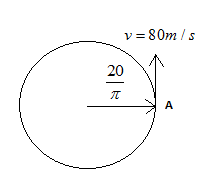
A particle moves along a circle of the radius \[\dfrac{{20}}{\pi }m\] with constant tangential acceleration. If the velocity of the particle is 80 m/s at the end of the second revolution after motion has begun, the tangential acceleration is
A. \[640\pi {\text{ m/se}}{{\text{c}}^2}\]
B. \[160\pi {\text{ m/se}}{{\text{c}}^2}\]
C. \[40\pi {\text{ m/se}}{{\text{c}}^2}\]
D. \[40{\text{ m/se}}{{\text{c}}^2}\]
Answer
575.1k+ views
Hint: The tangential acceleration is used to measure the change in the tangential velocity of a point with a specific radius with the change in time. The concept of linear and tangential acceleration is the same, but in the case of tangential acceleration, the direction of motion of the object is in a circular path; hence we can say tangential acceleration is the rate of change of tangential velocity on the circular path given as: \[{a_t} = \dfrac{{\vartriangle v}}{{\vartriangle t}}\]
In this question given the object starts from rest and moves with a constant tangential acceleration in a circular path. Tangential acceleration is to be calculated after the second revolution of motion.
Complete step by step solution:
The radius of the circular path \[r = \dfrac{{20}}{\pi }\]
Velocity in the second revolution \[v = 80{\text{ m/sec}}\]

Initial angular velocity, \[{\omega _0} = 0\]
Final angular velocity, \[\omega = \dfrac{{80}}{{\left( {\dfrac{{20}}{\pi }} \right)}} = 4\pi \]
Where angular velocity is given as: \[\omega = \dfrac{v}{r}\]
We know angular displacement is: \[\theta = \left( {2\pi } \right)\]
Hence, for the two revolution\[\theta = 2\left( {2\pi } \right) = 4\pi \]
The equation of motion is given as: \[{\omega ^2} = \omega _0^2 + 2a\theta \]
By substituting the values, we can write:
\[
{\left( {4\pi } \right)^2} = {0^2} + 2a\left( {4\pi } \right) \\
16{\pi ^2} = 8a\pi \\
a = 2\pi \\
\]
Also, we know the relation between angular and tangential acceleration is given as
\[
{a_t} = ar \\
= \left( {2\pi } \right)\left( {\dfrac{{20}}{\pi }} \right) \\
= 40 \\
\]
Hence the tangential acceleration after the second revolution is \[40\] m/$s^2$
Option (D) is correct.
Note: It is to be noted down here that the tangential acceleration of the particle is always perpendicular to the circle and it has a force known as centripetal force always directed towards the center of the circle.
In this question given the object starts from rest and moves with a constant tangential acceleration in a circular path. Tangential acceleration is to be calculated after the second revolution of motion.
Complete step by step solution:
The radius of the circular path \[r = \dfrac{{20}}{\pi }\]
Velocity in the second revolution \[v = 80{\text{ m/sec}}\]

Initial angular velocity, \[{\omega _0} = 0\]
Final angular velocity, \[\omega = \dfrac{{80}}{{\left( {\dfrac{{20}}{\pi }} \right)}} = 4\pi \]
Where angular velocity is given as: \[\omega = \dfrac{v}{r}\]
We know angular displacement is: \[\theta = \left( {2\pi } \right)\]
Hence, for the two revolution\[\theta = 2\left( {2\pi } \right) = 4\pi \]
The equation of motion is given as: \[{\omega ^2} = \omega _0^2 + 2a\theta \]
By substituting the values, we can write:
\[
{\left( {4\pi } \right)^2} = {0^2} + 2a\left( {4\pi } \right) \\
16{\pi ^2} = 8a\pi \\
a = 2\pi \\
\]
Also, we know the relation between angular and tangential acceleration is given as
\[
{a_t} = ar \\
= \left( {2\pi } \right)\left( {\dfrac{{20}}{\pi }} \right) \\
= 40 \\
\]
Hence the tangential acceleration after the second revolution is \[40\] m/$s^2$
Option (D) is correct.
Note: It is to be noted down here that the tangential acceleration of the particle is always perpendicular to the circle and it has a force known as centripetal force always directed towards the center of the circle.
Recently Updated Pages
A Slender homogeneous of length 2L floats partly immersed class 11 physics CBSE

Find the exponent of 10 in 75C25 class 11 maths CBSE

Seven identical circular planar disks each of mass class 11 physics CBSE

A right triangle whose sides are 15 cm and 20 cm is class 11 maths CBSE

Difference between universal gravitational constant class 11 physics CBSE

Find the error in the following sentence Error Correction class 11 english CBSE

Trending doubts
What is meant by exothermic and endothermic reactions class 11 chemistry CBSE

10 examples of friction in our daily life

One Metric ton is equal to kg A 10000 B 1000 C 100 class 11 physics CBSE

1 Quintal is equal to a 110 kg b 10 kg c 100kg d 1000 class 11 physics CBSE

Difference Between Prokaryotic Cells and Eukaryotic Cells

What are Quantum numbers Explain the quantum number class 11 chemistry CBSE




